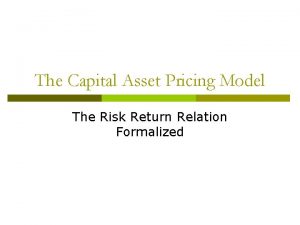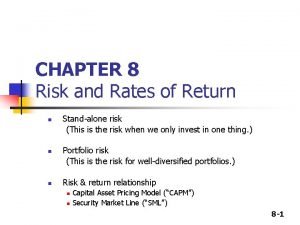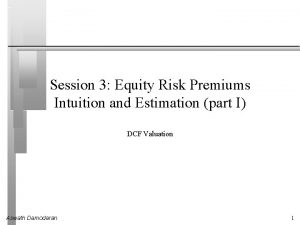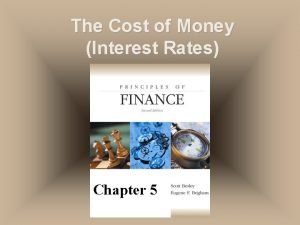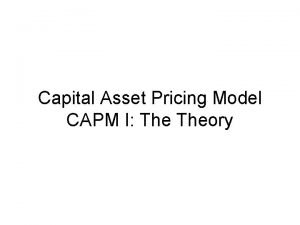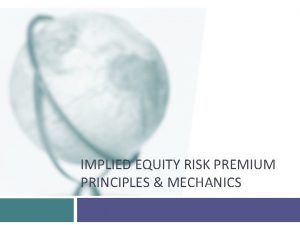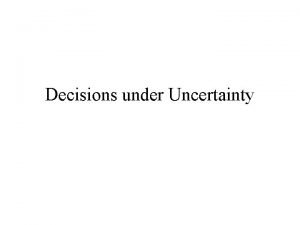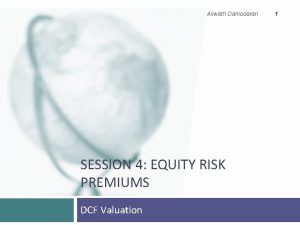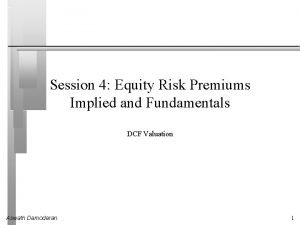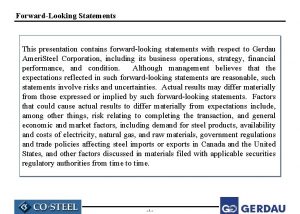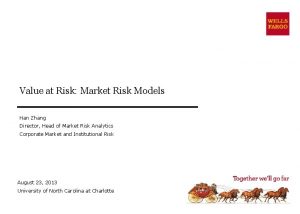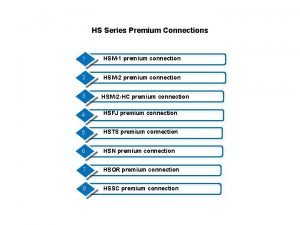ForwardLooking Market Risk Premium Weiqi Zhang National University



















- Slides: 19

Forward-Looking Market Risk Premium Weiqi Zhang National University of Singapore Dec 2010

Background Estimating risk premium • Historical average of realized excess returns – Backward-looking – The risk premium estimate can be negative even using an estimation period of 10 years (from 1973 to 1984) • Forward-looking risk premium – Our new approach is based on option prices (Relate forward-looking market risk premium to (1) investors’ risk aversion implied by the option market, and (2) forward-looking physical moments – variance, skewness and kurtosis)

Forward-Looking Risk Premium Theory Notation (over the time period t to t+τ) • Continuously compounded risk-free rate: rt(τ) • Dividend yield of the market portfolio: δt(τ) • Market portfolio’s cumulative return: Rt(τ)=ln(St+τ /St) • Mean, standard deviation, skewness and kurtosis: – under the physical measure P: μPt(τ), σPt(τ), θPt(τ), κPt(τ) – under the risk neutral measure Q: μQt(τ), σQt(τ), θQt(τ), κQt(τ)

Forward-Looking Risk Premium Theory • The equilibrium risk-free interest rate can be expressed as Idea: Expand impose the fact that riskneutral expected return equals risk-free rate minus dividend yield. – Can we express it in terms of physical moments?

Forward-Looking Risk Premium Theory • Assume the form of stochastic discount factor: • Rely on an approximate expression moment generating function of Rt*(τ) =Rt(τ) - μPt(τ) under measure P: • Uses the role of stochastic discount factor to link MGF under probability Q and P • Express risk neutral moments in terms of physical moments.

Forward-Looking Risk Premium Theory • Substitute the derived risk-neutral moment expressions into the risk-free rate equation and obtain a new market risk premium expression entirely based on physical return moments: Proposition 1 Under Assumption 1, the τ-period market risk premium can be expressed as a function of investors’ risk aversion, physical return variance, skewness and kurtosis: To apply, one needs to estimate γ, σPt(τ), θPt(τ), κPt(τ).

Econometric Formulation Estimate γ using GMM • The risk-neutral moment expressions can also be used to derive a volatility spread formula similar to that of Bakshi and Madan (2006): • In order to implement, one needs to have estimates for (1) the risk-neutral return volatility and (2) the physical return volatility, skewness and kurtosis.

Econometric Formulation • A model-free risk-neutral volatility can be derived via the typical mimicking approach using an option portfolio: where

Econometric Formulation • For the physical return moments, we use forward-looking physical return moments deduced from an estimated NGARCH(1, 1) model. • Estimate by QMLE with a moving window of 5 years of daily S&P 500 index returns. Obtain σt+1 and 5 years of standardized residuals for the bootstrapping usage later.

Econometric Formulation • The cumulative physical return volatility can be analytically computed using the formula: • The physical skewness and kurtosis are computed by bootstrapping (the smooth stratified bootstrap method of Pitt 2002 and generating 100, 000 sample paths)

Empirical Analysis • Data source: Option. Metrics for option prices, S&P 500 index values, risk-free yield curves. • Data period: daily from January 1996 to October 2009. • Set the target return horizon to 28 calendar days, i. e. , τ = 28. The risk-free rate for 28 calendar days is obtained by interpolating the risk-free yield curve. • Set the observation date to 28 calendar days before each monthly option expiration date. Use a moving window of 60 monthly data points.

Empirical Analysis Risk aversion • None of the 106 rolling GMM over-identification tests of the model is rejected. (The instruments are: constant and risk-neutral return variance being lagged one, two and three periods. ) • Range of γ: 1. 8 to 7. 1 • Smallest t(γ): 2. 62

Empirical Analysis

Asset Pricing Implications • The relationship between the change in the forwardlooking risk premium and the excess holding period return – Price equals the future cash flows discounted at the cost of capital (risk free rate + risk premium). – Holding period return (change in price) should thus be affected by a change in the discount rate and/or in the expected cash flows. • An empirical test: – predictions: β 1 < 0 and β 2 > 0.

Asset Pricing Implications Proxy for EPS: (1) current EPS as expectation (2) analyst forecasted EPS in I/B/E/S

Asset Pricing Implications Liquidity and the forward-looking risk premium • Amihud (2002) used data from 1964 to 1996 to find – A positive relationship between lagged illiquidity and excess return. – A negative relationship between unexpected illiquidity and contemporaneous excess return. – The presence of illiquidity risk premium in the stock market • Is illiquidity risk premium also reflected in FLRP?

Asset Pricing Implications • Replicate the Amihud (2002) study using our data from Jan 2001 to Dec 2008.

Asset Pricing Implications • How about FLRP and illiquidity?

Conclusion • Propose a new approach for estimating market risk premium on a forward-looking basis. Empirically, the estimates were all positive and were higher during the recession and/or crisis periods. • The forward-looking risk premium estimate is consistent with the asset pricing implications such as the holding period return behavior and the illiquidity risk premium.
 Credit risk market risk operational risk
Credit risk market risk operational risk Market risk premium
Market risk premium Market risk premium formula
Market risk premium formula Brazil country risk premium
Brazil country risk premium Malaysia weiqi association
Malaysia weiqi association Weiqi malaysia
Weiqi malaysia Default risk premium
Default risk premium Arbitrage pricing theory formula
Arbitrage pricing theory formula Implied equity
Implied equity Markowitz risk premium
Markowitz risk premium Aswath damodaran erp
Aswath damodaran erp Damodaran erp
Damodaran erp Leader follower challenger nicher
Leader follower challenger nicher Segmentation levels
Segmentation levels Risk projection attempts to rate each risk in two ways
Risk projection attempts to rate each risk in two ways Risk reduction vs risk avoidance
Risk reduction vs risk avoidance Relative risk calculation
Relative risk calculation Residual risk and secondary risk pmp
Residual risk and secondary risk pmp Ar = ir x cr x dr
Ar = ir x cr x dr Absolute risk vs relative risk
Absolute risk vs relative risk

